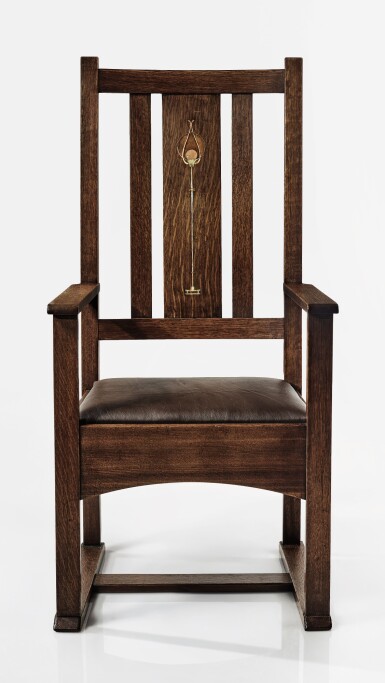Important Design
Important Design

Property of a Private Collection, London, England
HARVEY ELLIS | ARMCHAIR
Auction Closed
December 12, 09:10 PM GMT
Estimate
20,000 - 30,000 USD
Lot Details
Description
Property of a Private Collection, London, England
HARVEY ELLIS
ARMCHAIR
circa 1903
en suite with the following lot
executed by the Craftsman Workshops of Gustav Stickley, Eastwood, New York
inlays executed by the workshop of George Henry Jones, New York
oak, pewter and copper inlays, leather upholstery
with firm’s decal and with applied name card printed with the original owner's name Mrs. Michael Padden and with applied paper label for KINSTLER'S STORAGE WAREHOUSE 300-302-304 WEST 124th ST. NEW YORK
46⅞ x 23 x 24 in. (119.1 x 58.4 x 61 cm)
Michael and Helen Padden
Thence by descent
Stephen Gray and Robert Edwards, eds., Collected Works of Gustav Stickley, New York, 1981, p. 52 (for a related model with related inlay decoration)
Stephen Gray, The Early Work of Gustav Stickley, New York, 1987, p. 6
David Cathers, Stickley Style: Arts and Crafts Homes in the Craftsman Tradition, New York, 1999, p. 93 (for a related model with related inlay decoration)
Tod M. Volpe and Beth Cathers, Treasures of the American Arts and Crafts Movement: 1890-1920, New York, 1988, p. 36 (for the model in the collection of Carnegie Museum of Art)
Kevin P. Rodel and Jonathan Binzen, Arts and Crafts Furniture: From Contemporary to Classic, Newtown, CT, 2003, p. 100
Linda H. Roth and Elizabeth Mankin Kornhauser, eds., At Home with Gustav Stickley: American Arts & Crafts from the Stephen Gray Collection, London, 2008, p. 90
These iconic inlaid armchairs designed by Harvey Ellis exemplify craft and honesty in both their construction and materials. Gustav Stickley became enamored with the ideals of the Arts and Crafts movement soon after a trip to England in 1898, where he formed a fast friendship with William Morris. Stickley began to craft carefully handmade furniture in oak that revived traditional methods of both construction and inlay. Harvey Ellis, a talented young architect that worked in the Stickley Studios in 1903, was influential in changing the direction of the Stickley Studios. During the tenure of Ellis, the furniture at the Stickley Studios became lighter, and was distinguished by the use of stylized inlay as seen on the present lots which feature abstracted flowers executed in copper and pewter. Ellis was clearly influenced by the work of English designers like Charles Rennie Mackintosh and Mackay Hugh Baillie Scot in the flowing designs he employed on the present lots. Even more impressive, both of these chairs retain the original calling cards of the first owners, Michael and Helen Padden. A model of the same chairs with variant inlay patterning is held in the permanent collection of the Metropolitan Museum of Art in New York.
